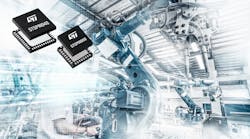High-Current Motor Drivers Take “Control” of Industrial, Consumer Robots
STMicroelectronics is upping its game in power electronics with a family of motor drivers that can control the brushed DC and stepper motors at the heart of high-end industrial and consumer electronics.
The STSPIN9 family of fully integrated motor-driver ICs has virtually everything required to carefully control the high-current motors in applications ranging from factory equipment, industrial and consumer robots, to home appliances. The chips bring control logic, a power stage comprised of a gate driver and power FETs that deliver voltages of up to 58 V and currents of up to 5.0 A to propel the motor, and system protection features. A pair of operational amplifiers (op amps) are placed in the package for current sensing.
The devices are rated for high reliability, including protection features such as overcurrent, overtemperature, short-circuit protection, and bus-voltage detection with undervoltage lockout (UVLO).
The Pivotal Role of the Motor Driver
Smooth and effective motor control tends to come down to choosing the best motor driver for the job.
A motor driver is used to supply the voltage and current of the windings inside AC and DC motors, and in turn, achieve the desired speed, torque, direction, and other operating characteristics of electric motors.
A motor driver serves as the interface—not unlike a gate driver—between the microcontroller (MCU) at the heart of the device that pumps out the pulse-width-modulation (PWM) signals to control the duty cycle, frequency, and dead time of the power supply, and the MOSFETs or other power switches that deliver voltage and current to control the motor.
The MCU can rarely supply sufficient current to drive the gate terminals of the FETs powering the motor by itself. Since it’s in charge of amplifying the current, the motor driver tends to make or break the circuit.
Electric motors must be as efficient as possible, since they suffer from diverse sources of power dissipation, including the switching losses and drain-to-source on-resistance (RDS(on)) of the FET driving it. While it’s possible to upgrade the FETs themselves to reduce power losses due to resistance or other parasitics, other techniques can be used. These include increasing the slew rate, reducing PWM output frequency, or using different modes of PWM modulation, all of which can be managed by a motor driver.
It’s preferred to use separate gate drivers and power FETs to control and drive electric motors that must handle higher power levels, including the high-frequency motors at the heart of electric vehicles (EVs). But when smaller amounts of power are at play and costs and space are more serious constraints, it can make more sense to use motor drivers—à la the STSPIN948 and STSPIN958 from STMicroelectronics.
What’s Inside a Modern Motor-Driver IC?
The first offering in the STSPIN9 family, the STSPIN948, contains dual full bridges that can be configured to work in a wide range of different modes, giving its customers flexibility to control different motors and even several electric motors at the same time. Featuring current control based on PWM with a fixed off-time or a programmable limit, it supplies up to 4.5 A of drive current in its 7- × 7-mm VQFPN48 package.
The STSPIN958 contains one full bridge that can pump out up to 5 A of current to control a single bidirectional brushed DC motor, a pair of electric motors that rotate in a single direction, or a higher-current one-direction motor (by paralleling outputs). Since it also features a fixed off-time or programmable current control as well as dual half-bridge, single full-bridge, and half-bridge parallel connections, the IC supports seven different driving methods in its 5- × 5-mm VFQFPN32 package.
In general, increasing the slew rate (dV/dt) of the power switch in the motor-driver IC also improves the dynamic response times of the system, resulting in more accurate control of PWM. While it’s preferred to increase the slew rate to reduce dead time and related power losses during switching, the tradeoff is that these speeds can cause excess electromagnetic interference (EMI) and other electric noise.
For flexibility, the power FETs in the motor drivers support a resistor-programmable slew rate, including 0.3, 0.6, 1.2, and 2.0 V/ns, depending on the power and noise requirements of the system.
In any power FET, on-resistance (RDS(on)) is a major source of inefficiency in power electronics. To keep power losses in check, each power MOSFET in the STSPIN9 family features only 200 mΩ of RDS(on).
With a very short propagation delay of 280 ns, ST said the motor-driver ICs deliver fast dynamic response and, thus, more accurate control of PWM signals. This results in a higher fidelity reproduction of the power switching waveforms in response to the PWM from the MCU. A short propagation delay is valuable in motor drivers, as it also enables the gate driver to deliver tighter dead-time management.
In general, a gate driver must supply enough current to turn the FET on and off as fast as possible. Doing so reduces the dead time between the on and off cycles and the losses that can add up in the meantime.
But these fast transitions also raise the risk of voltage overshoots and result in excess EMI in the form of conducted ground currents. ST said the STSPIN9 intentionally adds a small amount of dead time to prevent “shoot through” failures, which can occur when a pair of power FETs in the power stage are both turned on, causing a rush of current that can short-circuit the power supply and cause it to deteriorate.
Pricing starts at $1.42 for the STSPIN958 and $2.35 for the STSPIN948 in 1,000-unit quantities.

